 |
| इयत्ता सातवी विज्ञान गती, बल आणि कार्य मराठी स्वाध्याय PDF |
या लेखात, आम्ही विज्ञान गती, बल आणि कार्य विषयासाठी इयत्ता सातवी मराठी सोल्यूशन्स देऊ. इयत्ता सातवी मधील विद्यार्थी पाठ्यपुस्तकांमध्ये उपस्थित असलेल्या व्यायामांसाठी प्रश्न आणि उत्तरे डाउनलोड आणि कॉपी करण्यास सक्षम असतील.
इयत्ता सातवी विज्ञान गती, बल आणि कार्याच्या पुस्तकात महाराष्ट्र बोर्डाच्या अभ्यासक्रमातील सर्व प्रश्नांचा समावेश आहे. येथे सर्व प्रश्न पूर्ण स्पष्टीकरणासह सोडवले आहेत आणि डाउनलोड करण्यासाठी विनामूल्य उपलब्ध आहेत. महाराष्ट्र बोर्ड इयत्ता सातवी विज्ञान गती, बल आणि कार्याचे पुस्तक खाली दिले आहे. आम्हाला आशा आहे की आमच्या इयत्ता सातवी वीच्या विज्ञान गती, बल आणि कार्याचे पुस्तक तुमच्या अभ्यासात मदत करेल! जर तुम्हाला आमचे इयत्ता सातवी चे पुस्तक आवडले असेल तर कृपया ही पोस्ट शेअर करा.
इयत्ता सातवी विज्ञान गती, बल आणि कार्य स्वाध्याय
|
मंडळाचे नाव |
Maharashtra Board |
|
ग्रेडचे नाव |
सातवी |
|
विषय |
विज्ञान गती, बल आणि कार्य |
|
वर्ष |
2022 |
|
स्वरूप |
PDF/DOC |
|
प्रदाता |
|
|
अधिकृत संकेतस्थळ |
mahahsscboard.in |
समाधानासह महाराष्ट्र बोर्ड आठवा स्वाध्याय कसे डाउनलोड करायचे?
महाराष्ट्र बोर्ड सातवी स्वाध्याय PDF डाउनलोड करण्यासाठी खालील स्टेप्स फॉलो करा:
- वेबसाइट- Hsslive ला भेट द्या. 'स्वाध्याय' लिंकवर क्लिक करा.
- महा बोर्ड सातवी स्वाध्याय PDF पहा.
- आता महाराष्ट्र बोर्ड सातवी स्वाध्याय तपासा.
- डाउनलोड करा आणि भविष्यातील संदर्भांसाठी जतन करा.
इयत्ता सातवी विज्ञान गती, बल आणि कार्य स्वाध्याय उपाय
इयत्ता सातवी स्वाध्याय मधील विद्यार्थी खालील लिंक्सवरून विज्ञान गती, बल आणि कार्याचे उपाय डाउनलोड करू शकतील.
Class 7 Science Chapter 7 Motion, Force and Work Textbook Questions and Answers
1. Fill ¡n the blanks with the proper words from the brackets.
(stationary, zero, changing, constant, displacement, velocity, speed. acceleration, stationary but not zero. inc reuses)
Question a.
If a body traverses a distance in direct proportion to the time, the speed of the body is ……………… .
Answer:
constant
Question b.
If a body is moving with a constant velocity, its acceleration is ……………… .
Answer:
zero
Question c.
……………. is a scalar quantity.
Answer:
Speed
Question d.
…………….. is the distance traversed by a body in a particular direction in unit time.
Answer:
Velocity
2. Observe the figure and answer the questions.
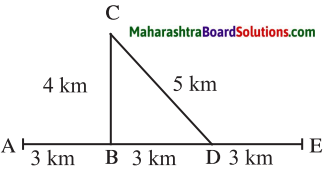
Sachin and Sarneer started on a motorbike from place A, took the turn at 13, did a task at C, travelled by the route CD to D and then went on to E. Altogether, they took one hour for this journey. Find out the actual distance traversed by them and the displacement from A to E. From this, deduce their speed. What was their velocity from A to E in the direction AE’? Can this velocity be called average velocity?
Question a.
Observe the figure and answer the questions
Sachin and Sarneer started on a motorbike from place A, took the turn at 13, did a task at C, travelled by the route CD to D and then went on to E. Altogether, they took one hour for this journey. Find out the actual distance traversed by them and the displacement from A to E. From this, deduce their speed. What was their velocity from A to E in the direction AE’? Can this velocity be called average velocity?
Answer:
1. Actual distance = AB⎯⎯⎯⎯⎯⎯⎯⎯ + BC⎯⎯⎯⎯⎯⎯⎯⎯ + CD⎯⎯⎯⎯⎯⎯⎯⎯ + DE⎯⎯⎯⎯⎯⎯⎯⎯ = 3 + 4 + 5 + 3
Actual distance = 15 km
2. Displacement = AB⎯⎯⎯⎯⎯⎯⎯⎯ + BD⎯⎯⎯⎯⎯⎯⎯⎯ + DE⎯⎯⎯⎯⎯⎯⎯⎯
= 3 + 3 + 3
Displacement = 9 km
3. Speed = Distance travelled Total time
Distance = 15 km = 15 × 1000 = 15000 m
Time = 1 hr = 1 × 60 × 60 = 3600 sec.
s = 150003600 or s = 15 km1 hour = 15km/hour
= 4.16 m/sec. or 15 km/hour
4. Velocity = Distance travelled Total time
Displacement = 9 km = 9 × 1000 = 9000 m
Time = 1 hr = 1 × 60 × 60 = 3600 sec
V = 90003600 or V = 9 km1 hour = 9 km/hour
= 2.5 m/sec. or 9 km/hour
5. Yes, this velocity can be called as average velocity.
3. From the groups B and C, choose the proper words, for each of the words in group A.
Question a.
From the groups B and C, choose the proper words, for each of the words in group A.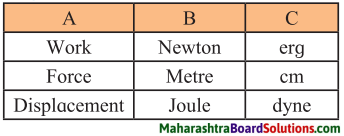
Answer:
| Group ‘A’ | Group B’ | Group ‘C’ |
| Work | Joule | erg |
| Force | Newton | dyne |
| Displacement | Metre | cm |
4. A bird sitting on a wire, flies, circles around and comes back to its perch. Explain the total distance it traversed during its flight and its eventual displacement.
Question a.
Answer:
The total distance the bird has traversed is the length of the distance covered by circling, but the eventual displacement are the bird is zero as its initial and final position are one and the same.
5. Explain the following concepts in your own words with everyday examples: force, work, displacement, velocity, acceleration, distance.
Question a.
Explain the following concepts in your own words with everyday examples: force, work, displacement, velocity, acceleration, distance.
Answer:
1. Force: The interaction that brings about the acceleration is called force.
e.g: An ox is pulling a cart, applying brakes to a bicycle, lifting heavy iron object with a crane.
2. Work: When an object is displaced by applying a force on it, work is said to be done.
e.g: A bucketful of water is to be drawn from a well and taken to the home by walking from well to home.
3. Displacement: The minimum distance
traversed by a moving body in one direction from the original point to reach the final point is called displacement.
e.g: A rolling of a ball from point A to point B in the same direction.
4. Velocity: Velocity is the distance traversed by a body in a specific direction in unit time.
e.g: A truck is covering a distance of 40km from A to D in a straight line in 1 hour.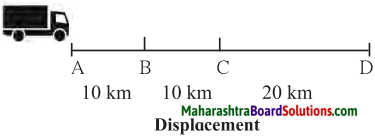
5. Acceleration: It is change in velocity per second. It can be deduced.
Acceleration = Change in velocity Time taken for change
e.g: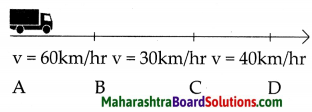
(i) In the above example a truck covered the distance AB at velocity of 60 km/hr, BC at 30 km/hr and CD at 40 km/hr. (ii) It means that the velocity for the distance CD is greater than the velocity for the distance BC. (iii) From the number of seconds required for this change in velocity to take place, the change in velocity per second can be deduced. This is called acceleration (iv) Distance: The length of the route actually traversed by a moving body irrespective of the direction is called distance.
e.g: Ranjit travelled 1km. from his home to school.
6. A ball is rolling from A to D on a flat and smooth surface. Its speed is 2 cm/s. On reaching B, it was pushed continuously up to C. On reaching D from C, its speed had become 4 cm/s. It took 2 seconds for it to go from B to C. What is the acceleration of the ball as it goes from B to C.

Question a.
A ball is rolling from A to D on a flat and smooth surface. Its speed is 2 cm/s. On reaching B, it was pushed continuously up to C. On reaching D from C, its speed had become 4 cm/s. It took 2 seconds for it to go from B to C. What is the acceleration of the ball as it goes from B to C.
Answer:
As its initial and final positions are one and the same.
Initial Velocity = 2 cm/s.
Final Velocity = 4 cm/s
Time taken for the change in velocity from B to
D = 4 cm/s – 2 cm/s = 2 cm/s
7. Solve the following problems.
Question a.
A force of 1000 N was applied to stop a car that was moving with a constant velocity. The car stopped after moving through 10m. How much is the work done?
Answer:
Force (F) = 1000 N
displacement (s) = 10m
work done (W) = ?
W = Fs
= 1000 × 10
W = 10,000 Joule
Question b.
A cart with mass 20 kg went 50 m in a straight line on a plain and smooth road when a force of 2 N was applied to it. How much work was done by the force?
Answer:
Force (F) = 2 N
Displacement (s) = 50 m
Work done (W) = ?
W = Fs
= 2 × 50
W = 100 Joule
Project:
Question a.
Collect information about the study made by Sir Isaac Newton regarding force and acceleration and discuss it with your teacher.
Class 7 Science Chapter 7 Motion, Force and Work Important Questions and Answers
Fill in blanks:
Question 1.
Displacement is a …………. quantity.
Answer:
vector
Question 2.
The …………. of an object can change even while it is moving along a straight line.
Answer:
velocity
Question 3.
The …………. velocity can be different at different times.
Answer:
instantaneous
Question 4.
Change in velocity per second is called …………. .
Answer:
acceleration
Question 5.
The interaction that brings about the acceleration is called …………. .
Answer:
force
Question 6.
The scientist …………. was the first to study force and the resulting acceleration.
Answer:
Sir Isaac Nezvton
Question 7.
Ability to do work is called …………. .
Answer:
Energy
Question 8.
W = …………. × S.
Answer:
F
Question 9.
Unit of work is …………. and …………. .
Answer:
Joule, erg
Question 10.
Unit of force is …………. and …………. .
Answer:
Newton, dyne
Question 11.
Force is a …………. quantity.
Answer:
vector
Question 12.
The velocity at a particular time is called …………. velocity.
Answer:
instantaneous
Question 13.
The …………. of a body is the distance traversed per unit time.
Answer:
speed
Question 14.
Unit of acceleration is …………. and …………. .
Answer:
m/s2 and cm/s2
Question 15.
Force is measured by the …………. that it produces.
Answer:
acceleration
Question 16.
Work done by a body with no displacement will be …………. .
Answer:
zero
Say whether True or False, correct the false 1 statements:
Question 1.
Velocity is distance travelled per unit of time.
Answer:
False. Speed is distance travelled per unit of time
Question 2.
In displacement, both distance and direction are taken into account.
Answer:
True
Question 3.
Speed = Distance/time.
Answer:
True
Question 4.
Change in speed per second is acceleration.
Answer:
False. Change in velocity per second is acceleration
Question 5.
Work done depends on the force and the displacement.
Answer:
True
Question 6.
C.G.S. unit of acceleration is m/s2.
Answer:
False. C.G.S. unit of acceleration is cm/s2.
Question 7.
M.K.S. unit of force is dyne.
Answer:
False. M.K.S. unit of force is Newton
Question 8.
Force is measured by the acceleration that it produces.
Answer:
True
Write the difference between the following:
Question 1.
Speed and Velocity
Answer:
| Speed | Velocity |
| 1. Speed is distance travelled per unit of time. | 1. Velocity is the distance traversed by a body in a specific direction in unit time. |
| 2. It is a scalar quantity. | 2. It is a vector quantity. |
| 3. Formula: Speed = Distance traversed Total time |
3. Formula: Velocity = Displacement Total time |
Question 2.
Distance and Displacement
Answer:
| Distance | Displacement |
| 1. The length of the route actually traversed by a moving body, irrespective of the direction is called distance. | 1. The minimum distance traversed by a moving body in one direction from the original point to reach the final point is called displacement. |
| 2. It is a scalar quantity. | 2. It is a vector quantity. |
Solve the following problems!
Question 1.
A bus travelled 200 km in the first 3 hours and then 100 kms for the next one and a half hours and then 120 kms for the next one and a half hours. What is the average velocity of the bus if it has moved in a straight line for the whole journey.
Answer: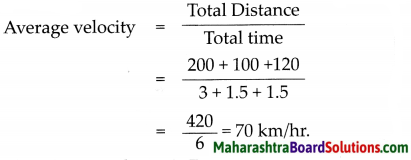
Question 2.
See the diagram and calculate the Distance and Displacement travelled by the body from A to I.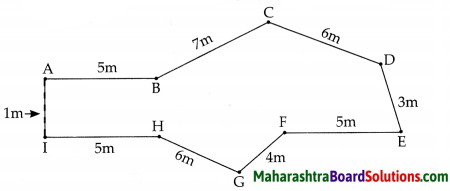
Answer:
Distance travelled =
A → B → C → D → E → F → G → H + I
= 5 + 7 + 6 + 3 + 5 + 4 + 6 + 5
= 41 m
Displacement = A → I in a straight line shortest distance
= 1m
Use your brainpower:
Question 1.
The unit of acceleration is m/s2, verify this.
Answer:
Question 2.
Acceleration is a vector quantity. Is force a vector quantity too?
Answer:
Yes, acceleration and force both are vector quantities, because both can be expressed completely only when magnitude and direction are given and the quantity which needs direction and magnitude both is called a vector quantity.
इयत्ता सातवी विज्ञान स्वाध्याय उपाय
- इयत्ता सातवी विज्ञान जिवंत जग: रूपांतर आणि वर्गीकरण मराठी स्वाध्याय PDF
- विज्ञान विज्ञान वनस्पती: रचना आणि कार्य
- विज्ञान विज्ञान नैसर्गिक संसाधनांचे गुणधर्म
- विज्ञान विज्ञान सजीवांमध्ये पोषण
- विज्ञान विज्ञान अन्न सुरक्षा
- विज्ञान विज्ञान भौतिक प्रमाणांचे मोजमाप
- विज्ञान विज्ञान गती, बल आणि कार्य
- विज्ञान विज्ञान स्थिर विद्युत
- विज्ञान विज्ञान उष्णता
- विज्ञान विज्ञान आपत्ती व्यवस्थापन
- विज्ञान विज्ञान सेल स्ट्रक्चर आणि सूक्ष्म जीव
- विज्ञान विज्ञान मानवी प्राण्यातील स्नायू प्रणाली आणि पाचक प्रणाली
- विज्ञान विज्ञान बदल – भौतिक आणि रासायनिक
- विज्ञान विज्ञान घटक, संयुगे आणि मिश्रणे
- विज्ञान विज्ञान आम्ही वापरत असलेली सामग्री
- विज्ञान विज्ञान नैसर्गिक संसाधने
- विज्ञान विज्ञान प्रकाशाचा प्रभाव
- विज्ञान विज्ञान ध्वनी: ध्वनी निर्मिती
- विज्ञान विज्ञान चुंबकीय क्षेत्राचे गुणधर्म
- विज्ञान विज्ञान ताऱ्यांच्या जगात






0 Comments:
Post a Comment